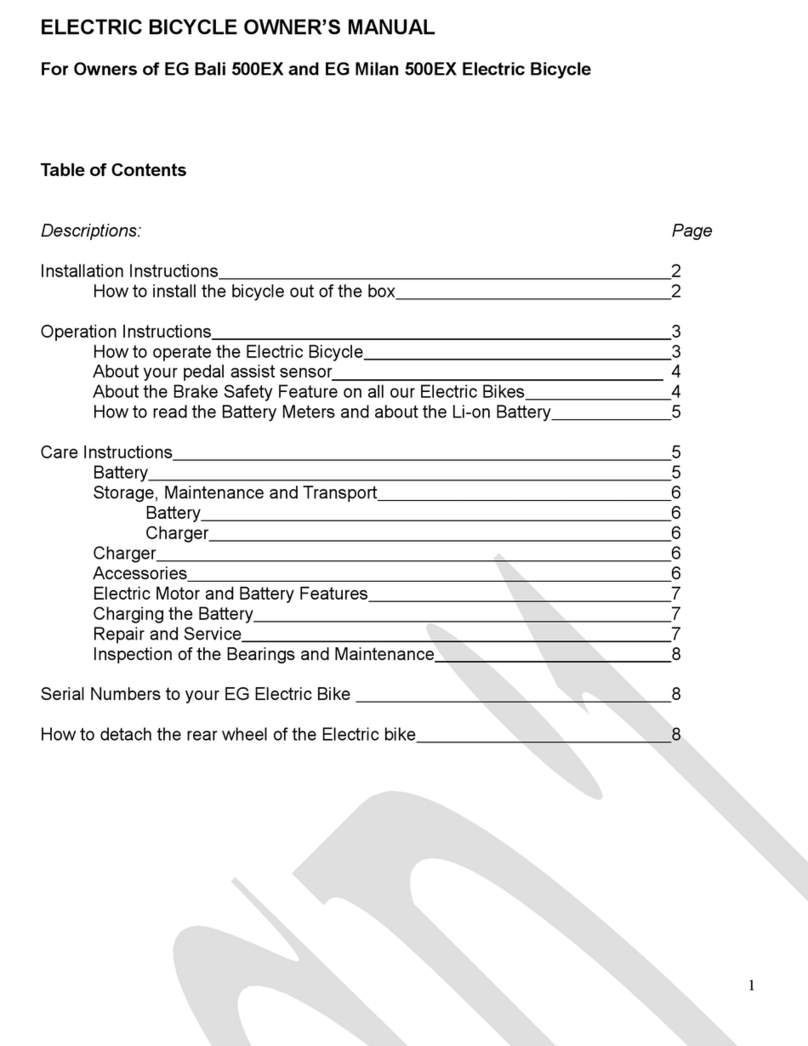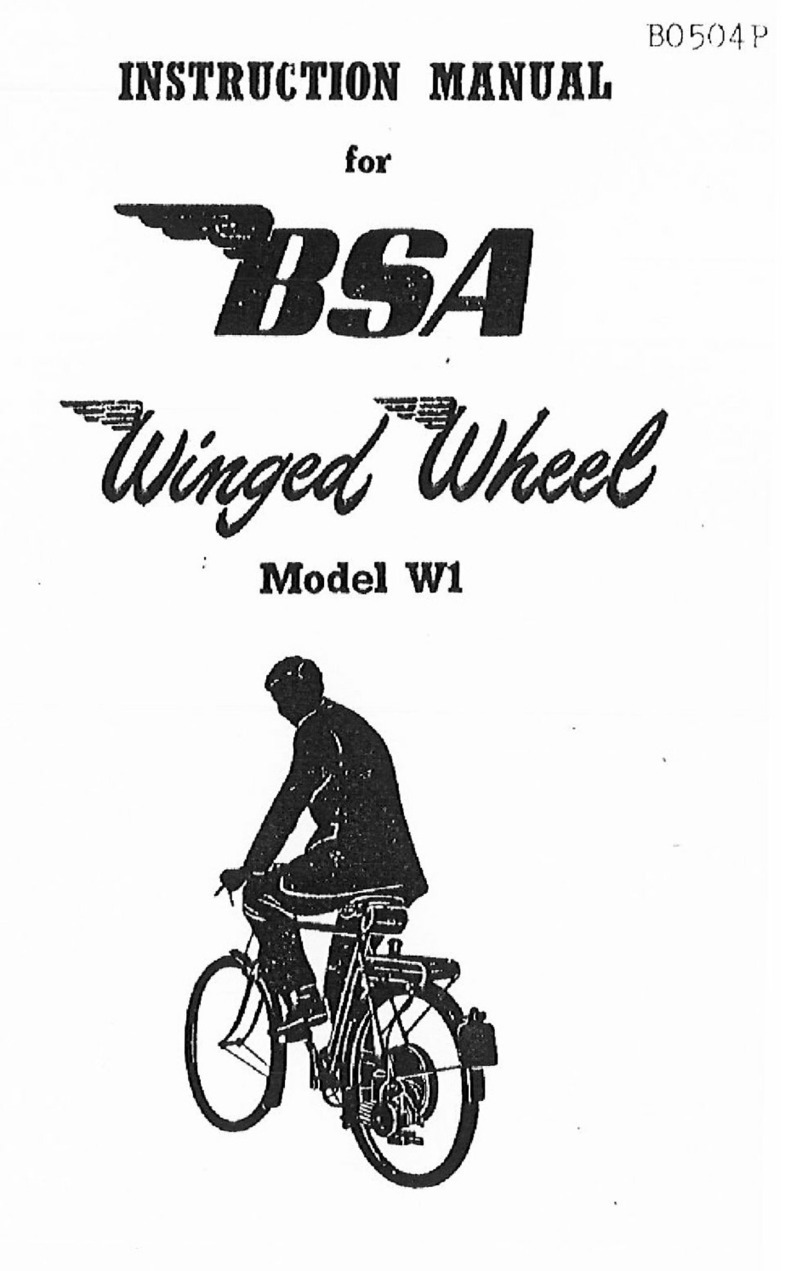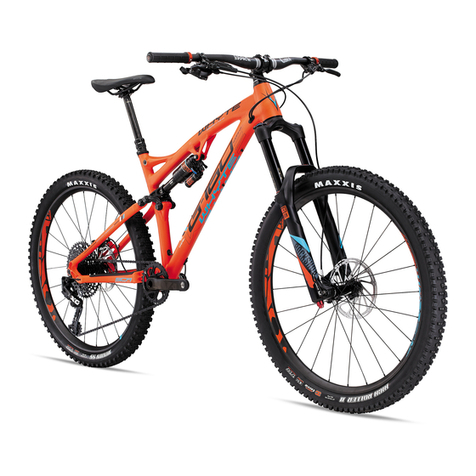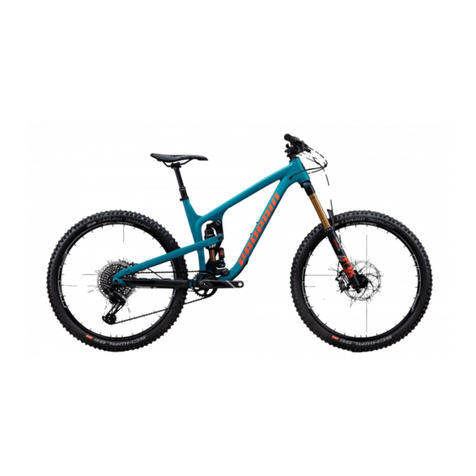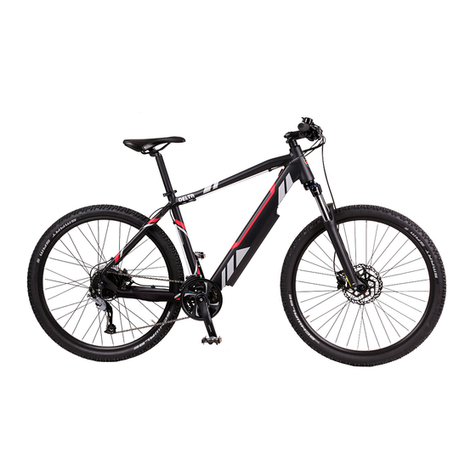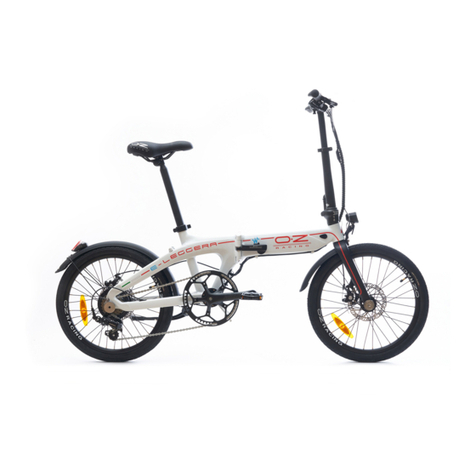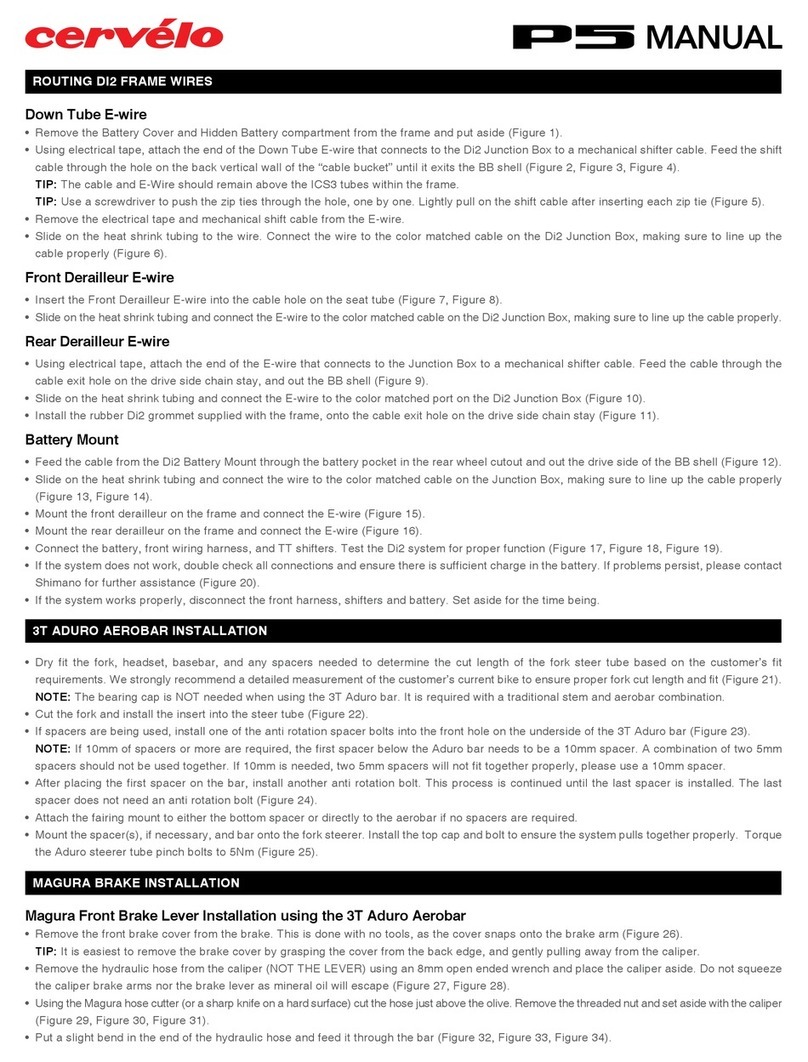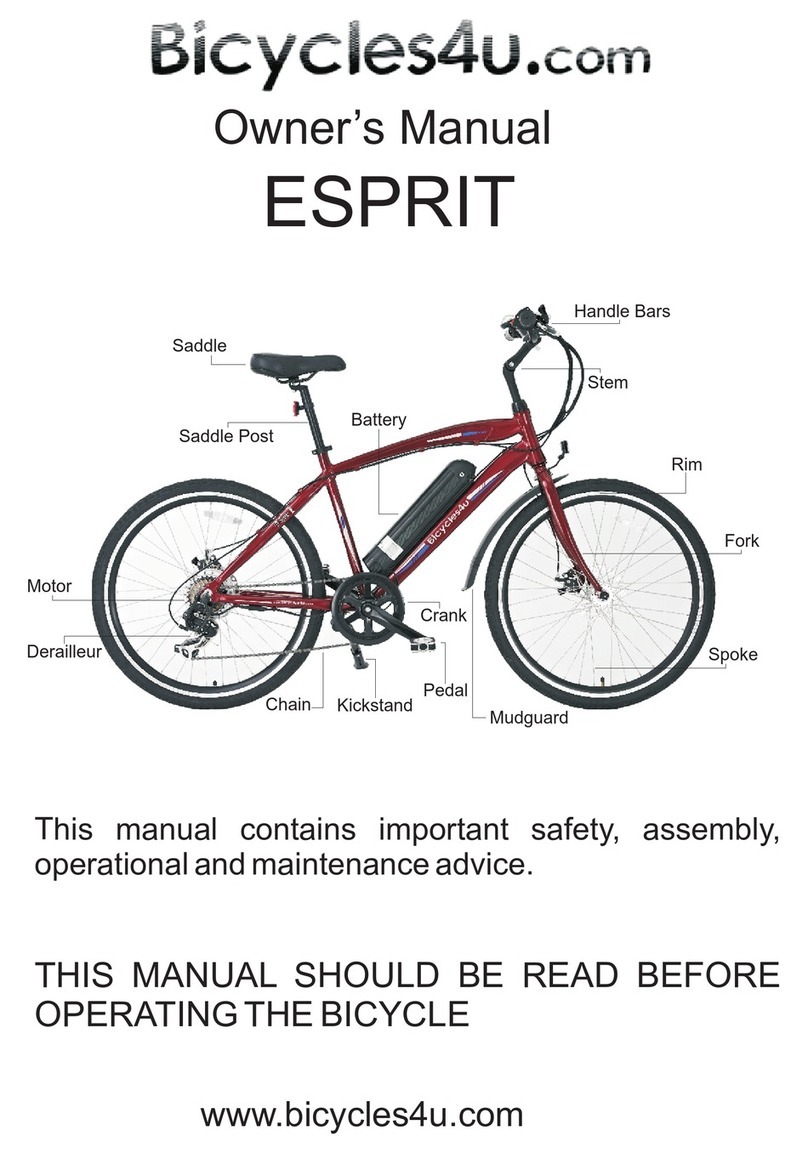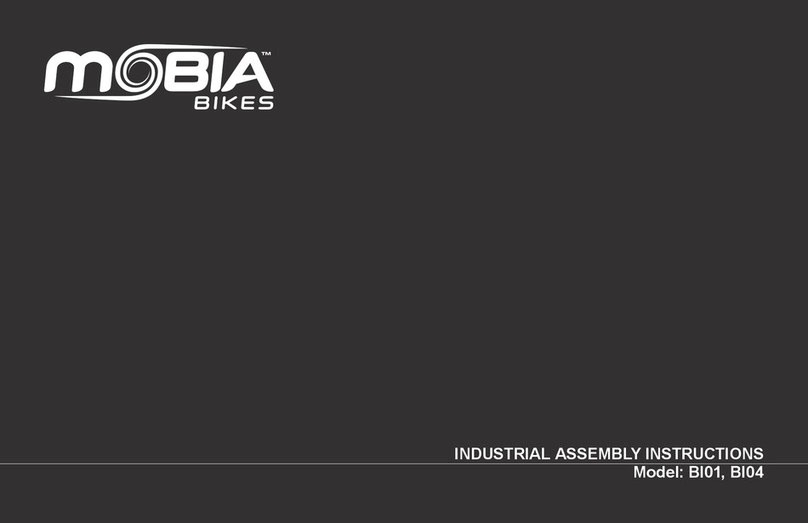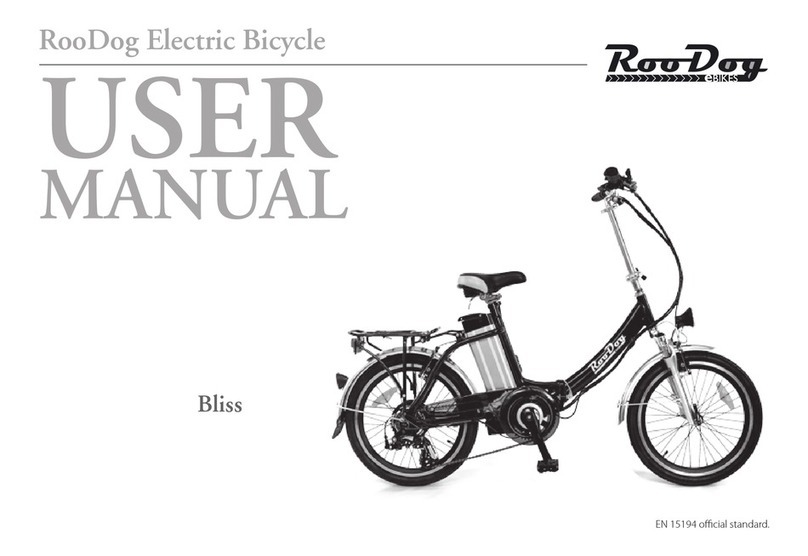3T Strada User manual

OPERATING
MANUAL
Gravel / Road Bike
ISO 4210:2014 Translation of the Original instruction manual

To start with, we’d like to provide you with some important information
about your new bicycle. This will help you make the most of its benets
and avoid any possible risks. Please read this instruction manual carefully
and keep it for your future reference.
Your bicycle has been handed over to you fully assembled and adjusted.
If this is not the case, please contact your specialist retailer to ensure that
this important work is completed or make sure you carefully read the en-
closed assembly instructions and follow all the directions given.
It is assumed that users of this product have a basic and sufcient knowl-
edge of how to use bicycles.
Everyone that:
• uses
• repairs or services
• cleans
• or disposes of
this bicycle has to understand and take note of the content and purpose of
this operating manual. If you have any further questions or have not quite
understood certain points, you should contact a specialist bicycle retailer
for your own safety.
All information contained in this operating manual relates to the design,
technology as well as care and maintenance of your bicycle. Please take
note of this information, as much of it is relevant to safety. Failure to con-
sider this information can cause accidents, falls and damage to property.
As modern bicycle technology is highly complex, we have chosen to only
describe the most important points.
In addition, this operating manual only applies to the bicycle with which it
was supplied.
For more specific technical details, please refer to the enclosed
notes and instructions from the respective manufacturers of the
individual components used on the bicycle. If you are unsure about
a particular point, please contact your specialist retailer.
Before riding your bicycle on public roads, you should inform yourself
about the applicable national regulations in your specic country.
Firstly, here are a few important pointers as to the rider’s person which
are also very important:
• Always wear a suitable bicycle helmet adjusted to t
your head and wear it for every ride!
• Read the instructions supplied by your helmet manu-
facturer relating to tting the helmet properly.
• Always wear bright clothing or sportswear with reec-
tive elements when you ride. If you are riding in dif-
cult terrain, please wear suitable protective clothing,
e.g. body protectors. This is vital so that other people
can SEE YOU.
• Always wear tight clothing on your lower body, and trouser clips if re-
quired. Your shoes should be grippy and have stiff soles.
Even if you are an experienced bicycle user, please take the time to rst
read the chapter “Before your rst ride” and then carry out all the impor-
tant checks from the chapter “Before each ride”!
Please note that as a bike rider, you are particularly at risk on public roads.
Ensure that you protect yourself and others with responsible and safe
riding!
Dear Customer,
C2

Frame
Top tube
Down tube
Seat tube
Head tube
Chain stay
Seat stay
Seat
Seat post
Seat post clamp
Dropout
Derailleur cassette
Quick release
Rear derailleur
Front derailleur
Chain
Chain ring
Crank arm
Pedal
Stem
Handlebars
Brake lever
Shifter
Headset
Shifter cable
Brake cable
Fork
Disc brake caliper
Brake disc
Thru axle
Wheel:
Front wheel hub
Spoke
Tire
Rim
Valve
Bicycle parts
6
5
4
4
3
3
2
2
1
1
5
6
If you leave this page unfolded when you read this guide, you can immediately recognise which part of the bicycle is being referred to.
C3
7
8Fastening front wheel (bolted axle / thru axle / quick release)
7
Fastening rear wheel (bolted axle / thru axle / quick release)
8

RR Pro EN 3.2
The illustration shows the 3T Exploro Gravelbike version. The bike you purchased may look somewhat different. This manual describes
bicycles in the following categories: Road Racing bike, Triathlon/Time trial bike, Cyclocross bike, Single-speed bike/Fixie. This operating
manual only applies to the bicycle with which it was supplied.
Please carefully read all warnings and notes in this operating manual be-
fore using the bicycle. We recommend keeping the manual close to your
bicycle, so that it is always at hand.
Please ensure you read the chapters “Before the rst ride” and “Be-
fore each ride” before using the bicycle for the rst time!
If you lend your bicycle to a third party, please give them this operating
manual with the bicycle.
This operating manual contains different types of pointers – one providing
important information about your new bicycle and how to use it, a second
referring to possible damage to property and the environment, and a third
type warning against potential falls and serious damage, including physi-
cal injury. The fourth type of pointer asks you to comply with the correct
torque in order to prevent components from coming loose or breaking.
If you see this symbol, there is always a risk that the danger described
can occur!
The text which the warning covers always has a grey background.
Check that all quick releases are safe and secure every time you ride after
your bicycle was unused, even for a short period of time! Regularly check
that all bolts and components are secure.
Note that components made of composite materials, i.e. carbon bre, often
require a lower tightening torque (see “Bolted connections” section, page
26). Common parts made of carbon bre include the handlebars, stems,
seat posts and saddle rails, frames, forks, and cranks. Ask your specialist
retailer to instruct you on how to properly use and maintain these materials.
Never ride with your hands off the handlebars.
Safety information
C4
Modern bicycle technology is high tech! Working on bicycle parts
therefore requires expert knowledge, experience and specialist
tools! Please do not attempt to work on the bicycle yourself! Give
your bicycle to a specialist retailer for repair, servicing and maintenance!
Information: This symbol provides information about how
to use the product or highlights specic parts of the operat-
ing manual that are particularly important.
Warning: This symbol is aimed at warning you against im-
proper use that could result in damage to property or the
environment.
Danger: This symbol indicates possible dangers to your
health and life that could arise if specic actions are not
made or corresponding care is not taken.
Important bolted connection! Please adhere to the exact
recommended torque when tightening this connection.
The correct mounting torque is either displayed on the
component or listed in the table of torques in the “Bolt-
ed connections” section (page 26). A torque wrench has to be used
to achieve the precise prescribed torque. If you don’t own a torque
wrench then you should always leave this work up to a specialist
retailer! Parts which do not have the correct torque could fall off or
break! This can result in serious accidents!
The warnings break down as follows:

1
Contents
Introduction C2
Bicycle parts C3
Safety information C4
Hand-over documentation C5
Bicycle identication C6
Warranty C7
Contents 1
Imprint 1
For your safety 2
Before the rst ride 2
Before each ride 3
If you have had a fall 4
Legal regulations 5
Intended use 5
Adjusting the bicycle to the rider 6
Using quick releases and through axles 6
Through axles 7
Installing pedals 8
Setting up the seating position 8
Setting up the angle of the seat 9
Setting up the position of the
handlebars/stem 10
Setting up the brake levers 10
Children 11
Frame 11
Maintenance/upkeep 12
Chain 13
Wheels 14
Rims/tires 14
Tires and tire pressure 15
Tubeless tires 16
Tubular tires 16
Flat tire repair for conventional tires 16
Brakes 18
Gears 20
Triathlon/TT bike 22
Inspection plan 23
Lubrication 25
Bolted connections 26
Loose accessories 27
Loose luggage rack 27
Mudguards 27
Trailers 28
How to use carbon components 29
Transporting the bicycle 30
Liability for material faults (warranty) 31
Environmental protection tips 31
Inspections 32
Imprint
For questions concerning your bicycle please
always contact your dealer rst, only then in
case the manufacturer of the bicycle.
For contact details please refer to the war-
ranty section, back cover or other included
information of the brand/manufacturer.
Responsible for sales and marketing
inMotion mar.com
Rosensteinstr. 22, D-70191 Stuttgart,
Germany
Tel +49 711 35164091
Fax +49 711 35164099
info@inmotionmar.com
www.inmotionmar.com
Content and images
Veidt-Anleitungen
Friedrich-Ebert-Straße 32
D-65239 Hochheim, Germany
Legal inspection by a lawyer’s ofce special-
ising in intellectual property
This operating manual covers the require-
ments and scope of ISO 4210:2014.
In the case of delivery or use of this product
outside of the scope of the aforementioned
areas, the manufacturer of the bicycle is re-
quired to supply the necessary operating in-
structions.
© Multiplication, reprinting and translation as
well as any commercial use (including extracts,
in printed or digital form) is only permitted if
specically granted in writing in advance.
RR Pro EN Edition 3.2, October 2017

2
Modern braking systems might be
more powerful or have a different
functionality than those that you are
used to. Please familiarise yourself with the
brakes on a safe piece of land before setting
off on your rst ride with the bicycle!
If you use a bicycle with carbon bre rims,
please note that this material provides a sig-
nicantly worse braking effect in combination
with rim brakes than aluminium rims do!
Also remember that the effectiveness of
brakes can be different, often worse, than you
are used to in wet conditions or on slippery
surfaces. Please take the possibility of longer
braking distances and slippery surfaces into
account when riding!
If you are riding a single speed or a “xie”,
please familiarise yourself with its behaviour
under braking before your rst ride! Single
speed wheels with just one brake are not per-
mitted on public roads. Fixed-gear bikes do not
have a freewheel mechanism. The cranks al-
ways turn whenever the back wheel is turning.
If your bicycle has rubber or plastic
cage pedals, please familiarise your-
self with the grip which these offer. In
wet conditions, rubber and plastic pedals can
be very slippery!
Gear system
Electrical motor
For your safety
These instructions assume that you can already
ride a bicycle. It is not a teaching manual to help
you learn to ride. Nor is it meant to provide you
with information on setting up or repairing the
bike.
Always be aware that there are basic risks in-
volved in cycling. As a cyclist you are particularly
exposed to risk. Always be aware that you do not
have the same level of protection as you have in
a car, for example. You have neither airbags nor
bodywork around you. However you are travel-
ling more quickly and in other areas of the road
than a pedestrian. Accordingly, you should pay
particular attention to other road users.
When cycling, never wear headphones or use
a mobile telephone. Never cycle if you are not in
a condition to be in complete control of your bi-
cycle. This applies particularly if you have taken
medicines, alcohol or other drugs.
• If the road surface is
wet or slippery, adjust
your cycling style ac-
cordingly. Cycle more
slowly and brake care-
fully and early, as your
stopping distance is
signicantly increased.
• Adjust your speed in accordance with the ter-
rain and your cycling ability.
Your specialist bicycle retailer will be happy to
answer any further questions you have after
reading this manual.
Please ensure that your bicycle is ready for
use and is adjusted to t your body.
That means:
• Setting the position and xture of the seat and
handlebars
• Checking the assembly and settings of the
brakes
• Securing the wheels into the frame and fork
To ensure that you enjoy a safe and comfortable rid-
ing position, please allow your specialist retailer to set
up your handlebars and stem.
Adjust the seat to a safe and comfortable posi-
tion for you (see page 8).
Allow your specialist retailer to set up the brakes
so that the brake levers are always within easy
reach. Ensure that you know which lever operates
which brake (right/left)!
The right brake lever operates the rear wheel
brake, the left brake lever operates the front
wheel brake. Despite this, however, you should
still check if the same rule applies to your bike’s
levers before riding it for the rst time, as this can
sometimes vary.
Before the rst ride
Please also consult the additional operating
manuals of the individual component manu-
facturers, which were supplied with your bicy-
cle or available online.

3
If you are unsure of whether your bi-
cycle is in a sound technical condi-
tion, take it to a specialist retailer to
be checked instead of riding it!
It is particularly important if you use your bi-
cycle a lot, either through sports riding or daily
use, that you regularly have all the important
parts checked by a specialist retailer.
Frame and fork, suspension components
and other parts relevant to your safety such
as brakes and wheels are subject to heavy
Ensure that the wheels are securely fastened in
the frame and fork. Check that the quick release
skewers, through axles and all important nuts
and bolts are secure (see page 6 and page 26).
Possible positions of quick release skewers, through axles and
screw connections
Lift your bicycle up slightly and drop it onto the
ground from about 10 cm in the air. If it rattles
or makes another unusual noise, please ask a
specialist retailer to identify and x the problem
before you ride.
Push the wheels forwards with the brakes
pulled. The back brake should completely pre-
vent the back wheel from moving, while the
front brake should lift the back wheel off the
ground with its braking effect. Please take an
initial test ride in a safe place where you can
familiarise yourself with the new brakes! Mod-
ern brakes can behave completely different
under braking than those that you are perhaps
used to. The bicycle‘s steering should not rattle
under braking or exhibit any play.
Check the air pressure in the tires. You will nd
instructions as to the correct tire pressures on
the sides of the tires. Please adhere to the re-
quired minimum and maximum pressure! Where
no pressure values have been stated, 6.5 bar
/ 94 PSI are deemed to be a suitable pressure
for racing bicycles. Cyclocrosser tires may be
pumped up to 3– 4 bar / 43.5–58 PSI.
As a general rule of thumb, when you are
out on a ride, you can
check the tire pressure
by doing the following:
If you place your thumb
on a pumped up tire,
you should not be able
to signicantly change
its shape by applying
pressure.
Check the tires and rims. Scan them for any
damage, cracks or deformations, as well as embed-
ded particles, e.g. shards of glass or sharp stones.
If you should nd any cuts, rips or holes,
please refrain from riding! First have your bicycle
checked over by a specialist.
Before each ride
Before every ride, please check that:
• The brakes are working safely and are prop-
erly secured
• The cables and ttings are not leaking, if you
have a model with hydraulic brakes
• The tires are free of foreign objects and dam-
age, and the rims are not damaged and run
true, particularly after riding off road
• The tires have a sufcient tread depth
• The suspension components are working
properly and are safely secured
• The screws, nuts, through axles and quick re-
leases are rmely placed (see page 6 and 26).
• There are no deformations or cracks on the
frame and fork.
• The handlebars, stem, seat post and seat are
both correctly and securely fastened as well as
set up in the right position
• The seat post and seat are secure. Try turning
the seat or tipping it upwards or downwards. It
should not move.
• If you are using clipless/magnet pedals, please
check that they are working properly. The ped-
als should release easily and smoothly.

4
If you have had a fall
Check out the en-
tire bicycle for any
changes. These
might be dents
and cracks in the
frame and forks, or
bent components.
And if parts like
the handlebars or
saddle have been
displaced or twisted, you must check that these
parts are properly seated and functioning.
• Take a close look at both frame and forks. If
you inspect the surface from a variety of an-
gles, in most cases any deformations will be-
come clear.
• Ensure that the saddle, seat tube, stem and
handlebars are still in the correct position. If
they are not, DO NOT bend the component
back out of its changed position without slack-
ening off the relevant threaded connection.
When tightening components it is essential
that you observe the stipulated tightening
torque. You will nd the relevant values on
page 26 and in the section on “Quick releas-
es”, page 6.
• Check that both wheels are properly and se-
curely aligned within the frame and forks. Lift
the bicycle at both front and rear and spin the
relevant wheel to check. The rim must run
straight through between the brakes with-
out any contact. The tires must not touch the
brakes. For bicycles with disc brakes, inspect
the gap between the frame or forks and tires to
ensure that the wheel is not buckled.
• Check that both brakes are operating fully.
• Do not set off again without having checked
that the chain is sitting securely on both the
front chain wheel and rear sprockets. It must
be engaged fully with the cogs. If you set off
and the chain jumps off a cog you may fall, at
the risk of very severe injury.
If you notice any change in your bicycle, DO
NOT continue cycling. Do not retighten any loose
parts without rst checking them and always use
a torque wrench. Take the bicycle to your special-
ist dealer, describe the fall to him and have the
bicycle checked out!
Aluminium components are prone to
breaking without warning if they have
been deformed. Never use any com-
ponents which have been deformed or bent
after a fall, for example. Always replace such
components.
Carbon components can be seriously dam-
aged without displaying any visible evidence
of this. After a fall, have all carbon compo-
nents checked out by your specialist dealer.
Please make these checks before
continuing after a fall or if your bicy-
cle falls over!
Aluminium parts cannot be safely bent back
into shape, while carbon components can
sustain damage which is not visibly to the eye.
Allow the bike to be checked by a specialist
retailer.
wear, which can impact the operating safety
of these parts.
If you use parts for longer than their intend-
ed lifetime, these can fail without warning.
This can lead to falls and serious injury!

5
Legal regulations
Before riding your bicycle on public
roads, you should inform yourself
about the applicable national regu-
lations in your specic country.
This section provides informa-
tion on how the bicycle has to be
equipped to be permitted to partici-
pate in public road trafc.
Here you can nd out which light systems
have to be installed or carried with you and which
brakes the bicycle has to be equipped with.
There is also an explanation of which age restric-
tions apply and what age riders have to be to ride
where. The participation of children in public road
trafc is also addressed here. If there is an obli-
gation to wear a helmet, it is stated here.
Info
Bicycles are intended for transporting
one person at a time. If you are plan-
ning to transport additional people,
you should inform yourself about the applica-
ble national regulations in your specic coun-
try. If you would like to transport luggage, this
requires that your bicycle is tted with suitable
equipment. Children can only be transported
in children‘s seats or trailers intended for
this purpose. We recommend not taking any
chances when it comes to quality in this area!
Ensure that you do not exceed the maximum
permissible weight.
Maximum permissible weight: Rider‘s
weight + Bicycle weight + Baggage
weight
If your bicycle is equipped in line with national
law, the following is permitted:
Type 1
Racing bikes
and appropriately equipped Pedelecs/ youth
bikes/ single speed bikes/ xed-gear bikes
should be used on public roads, smooth surfaces
and paved streets. Participating in a competition
is only permissible if the manufacturer has de-
signed the bike to do so.
Manufacturers and dealers are not liable for
damage resulting from use outside of intended
use. This applies particularly to damage resulting
from non-adherence to the safety instructions,
e. g., in terms of:
Intended use
(see page C5)
The information provided in this operating man-
ual only applies to the types of bicycles listed on
the cover.
Information on individual models is labelled
accordingly.
Using the bicycle as intended also means
adhering to the operating, maintenance and up-
keep conditions described in this manual.
• Use on terrain
• Excess load
• Improperly repairing defects
These bikes are not designed for extreme im-
pact. This includes riding over steps, bike jump-
ing, extreme use in authorised biking competi-
tions, doing tricks and performing stunts.
Type 2
Triathlon /Time trial bikes
are used on public roads, smooth surfaces and
paved streets. Participating in a competition
is only permissible if the manufacturer has de-
signed the bike to do so.
Manufacturers and dealers are not liable for
damage resulting from use outside of intended
use. This applies particularly to damage resulting
from non-adherence to the safety instructions,
e.g., in terms of:
• Use on terrain
• Excess load
• Improperly repairing defects
These bikes are not designed for extreme im-
pact. This includes riding over steps, bike jump-
ing, extreme use in authorised biking competi-
tions, doing tricks and performing stunts.

6
A good gauge for measuring if the
wheel is safely clamped is if you
can only close the clamping lever
with the balls of your hands when the re-
sistance increases after closing the lever
about half way.
Type 3
Cyclocross bikes
and appropriately equipped youth bikes, single
speed/ xed-gear bikes should be used on public
roads and easy terrain, including unpaved path-
ways and designated cyclocross courses. Par-
ticipating in a competition is only permissible if
the manufacturer has designed the bike to do so.
Manufacturers and dealers are not liable for
damage resulting from use outside of intended
use. This applies particularly to damage resulting
from non-adherence to the safety instructions,
e.g., in terms of:
• Use on challenging terrain and riding over ob-
stacles.
• Excess load
• Improperly repairing defects
These bikes are not designed for extreme im-
pact. This includes riding over steps, bike jump-
ing, extreme use in authorised biking competi-
tions, doing tricks and performing stunts.
If you are not certain about which kind of bike you
have, ask your specialist retailer or the manufac-
turer about its use and limitations. Inform yourself
about current legislation before riding your bike on
public roads and pathways. Only ride on routes
which are permitted for your type of bicycle.
Please ensure that you read the
manufacturer‘s operating manual for
your stem. Only allow specialists to
work on your handlebars and stem, do not at-
tempt to do this yourself!
Possible positions of quick release skewers / through axles
Possible positions for adjusting bolted connections
Adjusting the bicycle to the rider
The seat post, seat, stem and handlebars can
only be tightened and secured with quick releas-
es or bolted connections.
* see page 26
Quick releases and through axles are systems
installed on the bicycle in place of bolted con-
nections. They consist of two parts: the clamp-
ing lever, which provides the necessary clamping
force, and the locking nut, which allows you to
regulate the clamping force. You can change the
setup of your quick release when the clamping
lever is open.
Loosening adjusting nuts
Using quick releases and through axles

7
Inappropriately installed wheels may
shift while you are driving or detach
from the vehicle. This may damage
the vehicle and expose the driver to severe
and life-threatening injuries. It is therefore im-
portant to take note of the following instruc-
tions:
• Ensure that your axle, drop-outs and
through axle mechanisms are free from dirt
and contamination.
• Ask your dealer for exact instructions on
the proper way to secure your wheel in the
through axle system on your bicycle.
• Fasten your wheel appropriately with the
through axle.
• Never use the bicycle unless you are sure
that the wheel has been properly secured
and cannot come loose.
Mounting
Place the wheel in the dropouts. The wheel hub
must be fastened securely in the dropouts. Close
the xing mechanism.
Ensure that the brake disk is properly inserted
into the brake calliper. Ensure that neither the
brake disk nor the hub or the brake disk fasten-
ing screws touch the lower parts of the fork. If
you do not know how to adjust the disk brakes of
your bike, please read the instructions provided
by your disk manufacturer.
• Check that all quick releases are
properly fastened before every ride.
• Make sure that all quick releases
and through axles are properly in place
even if the bike was only left unattended
for a short period of time.
• When it is closed, the quick release lever
should be flat against the frame, fork or
seat post!
• When it is closed, the end of the quick re-
lease lever should always point backwards.
This ensures that it cannot be opened
through contact during riding.
• The quick release lever for the wheel has
to be installed on the opposite side to the
brake disk, otherwise you could suffer
burns from the brake disk. The clamping
force of the quick release can also be re-
duced if it is heated by the brake disk.
Through axles
Through axles that mostly function – and must be
handled – like quick releases, are also currently
used in chassis in lieu of bolts.
The axle is screwed into the drop-out and se-
cures the hub between the two fork arms or the
drop-outs in the frame. With some systems, the
hub and axle are secured with a quick release le-
ver operated in the same way as a normal quick
release skewer. Systems in which the axle is only
inserted or screwed in and then fastened with a
screw also exist. Refer to the attached compo-
nent manufacturer instructions and allow your
dealer to explain the system to you in detail.
If your bicycle has one or several
through axles, please read the cor-
responding instructions provided by
the component manufacturer on how to oper-
ate and service these parts.
If your bicycle has components that
are xed with quick releases, ensure
they are locked too when you park
the bicycle.
Tightening adjusting nuts

8
Knee joint of the upper leg at
min. 90°, angle of arm 90°
The knee should be above the axle of the front pedal
Correct seat height
90˚
90˚
90˚
Determining the correct seat height
Set the saddle to what you think is the right
height. Sit on the bicycle. Enlist the help of an-
other person or support yourself against a wall
or a railing.
Bring one pedal down to its lowest position
and place your heel on it. Your leg should now
be fully stretched.
* see page 26
Installing pedals
If your bicycle was supplied without the pedals
pre-installed, these have to be attached with the
correct wrench. Please note that the pedals have
to be screwed in in different directions and se-
cured with a high mounting torque (see page 26).
Apply assembly grease to both threads.
Forwards
Setting up the seating position
Before you use your bicycle for the rst time, the
seating position has to be set up to suit your body
size. This is vital for riding safely and securely.
To do this, the seat‘s height, alignment and an-
gle have to be set up, as do the height and align-
ment of the handlebars with the stem.
In the case of clipless pedals, you are
able to adjust how much force is re-
quired to release the shoe from the
pedal. Please test this on your rst ride with
a setting that releases very easily! Regularly
clean your clipless pedals and keep them in
good condition with a suitable spray lubricant.
Ensure that you read the manufac-
turer‘s instructions before using clip-
less pedals. Practice clipping your
shoes in and out of the pedals‘ locking system
before your rst ride in a quiet, safe place.
Clipless pedals which do not properly release
are a safety hazard.
Please read the enclosed instruc-
tions from the respective manufac-
turer if you use pedals feature hook
or strap systems.
Practice taking your feet in and out of the
hooks and operating the strap releases in a
safe place. Tightened straps do NOT release
the feet! Possible consequences are falling
and injuries.

9
If you place your foot in its proper position for
cycling, your leg should now be lightly bent.
Your foot is in the right position for cycling
when its widest part is right above the pedal
spindle.
Children and people who are not
condent cyclists should be able to
touch the ground with the tips of both
feet. Otherwise, when stopping they run the
risk of falling and suffering serious injury.
If you are using clipless pedals, the pedal plates
should be adjusted so as to ensure your foot is in
this position. This prevents damage to your mus-
culoskeletal system and ensures the best pos-
sible delivery of power.
Patented seat post with two-screw locking mechanism
Patented seat post with one-screw locking mechanism
Attachment with seat clamp
Setting up the angle of the seat
When you have set the height of the seat, you
have to check that the angle of the seat is suit-
able. In general, the upper surface of the seat
should be horizontal. You can adjust this by loos-
ening the clamping bolts in the seat post.
* see page 26
Suspension seat post
Integrated Seatpost
If your bicycle is equipped with a so-called in-
tegrated seatpost or a seatpost with integrated
xture for operation and adjustment please read
the enclosed instructions from the respective
manufacturer.
Before you start riding, please test
to see if your seat post and seat
are secure. To do this, grab the
seat at the front and back and attempt to
turn it. It should not move.
7,5 cm
STOP

10
When you squeeze the brake levers
hard or all the way to the end of their
leverage, the braking force can in-
crease sharply! Please familiarise yourself
with this new braking behaviour. Ensure that
you receive and read the manufacturer‘s op-
erating manual.
Setting up the brake levers
Set up your brake levels in such a way that you
can safely apply them and brake comfortably.
Please familiarise yourself with which lever oper-
ates the front and which the rear brake!
Some brakes are now equipped with power
modulators. This guards against “overbraking”
and any dangerous locking of the wheels.
In order to be able to apply the brake lever if you
have smaller hands, in some models it is possi-
ble to position the brake levers closer to the han-
dlebars using special equipment. For more on
this, please read the enclosed instructions from
the respective manufacturer.
In some models it is possible to bring the brake
levers closer to the handlebars, using special de-
vices.
Set up the cable
tension in such a
way that the brake
levers do not touch
the handlebar grip,
even when they
are applied to their
fullest!
Threadless stem
Adjustable stem
Please ensure that you read the man-
ufacturer‘s operating manual for your
stem. Only allow specialists to work on
your handlebars and stem, do not attempt to do
this yourself!
Height change possible as follows:
• Exchange of tted spacers under or above the
stem
• Turning of the stem
• Exchange of the stem
Adjustment of stem tilt possible
Only to be carried out by a special-
ised dealer
Setting up the position of the handlebars/stem
Various types of stem are used on bicycles:
Changing the position of the stem
also changes the position of the
handlebars. You should always
be able to safely reach and use grips and
controls. Please ensure that all cables and
lines are long enough to allow you to turn
the handlebars in every possible way.
Quill stem
Height adjustment possible
STOP
When adjusting the height of the
seat, never pull the seat post further
out than the maximum extension
length marked! If your tube does not have a
maximum marking, then you must leave a
minimum insertion length of 7.5 cm.

11
Children
Only install children‘s seats on bicy-
cles which are suitable for this kind of
equipment.
Carbon bre frames and components are
not permitted to carry children‘s seats!
Never attach a children‘s seat to the seat post!
Wrap and protect all suspension and mov-
ing parts on the seat and seat post. Please
ensure that your child cannot trap its ngers
anywhere! This would result in a substantial
chance of injury!
Child bike trailers:
• Take no chances in terms of quality when buy-
ing child bike trailers.
• Only install child bike trailers on bicycles and
only using mounting parts approved or intend-
ed for this purpose by the manufacturer.
• It is easy to overlook a child bike trailer in traf-
c! Use a brightly coloured ag and approved
light system to ensure that it is easily seen. Ask
your specialist retailer about safety equipment.
• Bear in mind that when towing a trailer your bi-
cycle is much longer than it normally is. A bicycle
towing a trailer also behaves differently through
bends than one without a trailer. Accordingly,
you must be very careful in trafc. First prac-
tice with an empty trailer on safe ground with no
trafc, before setting out into the trafc.
Only install children‘s trailers on bicy-
cles which are suitable for this kind of
equipment.
Check whether the trailer manufac-
turer has stipulated a maximum load
and permitted maximum speed. You
must observe these values. In most countries,
children under the age of 16 are not allowed
to cycle towing a trailer by law.
Frame
Frame shapes vary according to the type and
function of the bike. Modern frames are made of
various materials, such as steel, aluminium al-
loys or carbon (carbon bre).
Top tube
Seat stay
Seat tube
Head tube
Down tube
Chain stay
Carbon frame
Lugged steel frame Welded aluminium frame

12
On no account should you ride with a
bent or broken frame. Never attempt
to repair damaged parts yourself.
Otherwise, there is a danger of accidents.
Faulty parts have to be replaced by a spe-
cialist retailer. Please only ride your bicycle
again when the parts affected have been re-
placed. Faults on the frame or other parts can
cause accidents. If your bicycle does not ride
in a straight line without any problems, this
can be due to a bent frame or fork. Please
contact a specialist retailer to have the frame
and fork checked and possibly to have the
bike realigned.
12345
Thanks to the evolution in materials and con-
struction techniques, nowadays it is possible to
produce all shapes of frames safely so they per-
form stably during riding. So despite a low step-
through, you can still be sure that your bicycle
is always safe on the roads, even with luggage
on board.
If your bicycle is stolen, it can be iden-
tied using its frame number. Please
always note down the full number in
the correct order. Otherwise it is impossible to
make a unique identication.
In the documentation you received from the
retailer when you purchased your bicycle,
there is also a section where the frame num-
ber is entered.
The frame number can also be engraved
on various parts of the frame. It is frequently
found on the seat tube, at the drop-outs or on
the bottom bracket casing.
As is the case for all mechanical
parts, bikes take on wear, tear and
heavy use. Because of heavy use,
different materials and components can react
to wear and tear in different ways. If a com-
ponent is used for longer than it is designed
for, it may suddenly stop working and possi-
bly lead to injury or cause additional damage.
Any kind of rip, puncture or colour change
seen in an overused area indicates that the
component’s use has reached its limit; the
component should in this case be replaced.
Please have your bicycle checked by
a specialist retailer on a regular ba-
sis. These experts can identify dam-
aged and worn parts and are able to advise
you in selecting replacements. Refrain from
repairing key parts yourself (frame, fork, han-
dlebars, stem, headset, brakes, lights).
Screws and torque spanners
When working on the bicycle, please
ensure that all screws are tightened to
the correct torque. The required torque is print-
ed on many parts with a screwed connection.
Measurements are given in Newton metres
(Nm) and applied with a torque wrench. It is
best to use a torque wrench that displays the
tightening torque as it is in use.
Otherwise screws can snap or break. If you
don’t own a torque wrench then you should al-
ways leave this work up to a specialist retailer!
A table listing the most important torques for
bolted connections is provided on page 26.
Maintenance/upkeep

13
Torque spanners
Chain
To ensure that it can work effectively, the chain
has to be cleaned and greased regularly (see
page 25). Dirt can be removed when washing
the rest of the bicycle. Otherwise you can clean
the chain by rubbing it with an oily clot. When the
chain is clean, it should be greased at the joints
with suitable lubricant. After being left to soak,
the excess lubricant should then be removed.
To ensure that the chain and gears
can work safely, the chain has to
have a certain level of tension. De-
railleur gear systems tense the chain auto-
matically. In the case of hub gears which were
installed without a chain tensioner, chains
which are too loose have to be tightened. Oth-
erwise they can come off and lead to a fall.
In the case of bicycles with adjust-
able dropouts, the mounting screws
of the axle housing should be loos-
ened and tightened, and not the axle nuts. If
the bottom bracket shell contains an eccentric
Chain tension
bush, please tighten the chain according to
the instructions provided by the correspond-
ing manufacturer.
Please ensure that axle nuts and
quick releases are correctly at-
tached!
1
2
3
10-15 mm
* see page 26
If your bicycle is equipped with a
belt drive, please read the attached
component manufacturer’s operating
instructions before rst use.
Belt drive
Dirt and permanent strain wear
the chain. The chain should be re-
placed as soon as it can be signifi-
cantly lifted (approx. 5 mm) from the front
chain ring. Many modern chains for derail-
leur gear systems no longer have chain
connectors. You therefore require special-
ist tools to open/change/close them. This
work should be carried out by a specialist
retailer.
Other chains are supplied/assembled with
chain connectors. In some cases, these can
be opened without the need for tools. These
chain connectors can also be used to repair
a damaged chain on a ride, if they have the
correct width for the drive train.

14
Rims are subject to a great deal of
strain and are vital to your safety on
the bike. Riding wears rims down
over time, particularly on bicycles with rim
brakes. If you notice any damage or the wear
indicators show dangerous levels of wear,
you should no longer ride with these rims.
Have them checked by a specialist retailer
and replaced if required.
Wear can weaken rims and lead to falls and
serious accidents.
Groove as a wear
indicator
Wheels
Checking the wheels
The bicycle is connected to the ground by the
wheels. The wheels are subject to a great deal of
strain through the uneven characteristics of the
ground and the weight of the rider.
Thorough checks and centring work on the
wheels are undertaken before they are shipped.
However, during the rst few kilometres of riding,
the spokes bed in.
• After the rst 100 kilometres (62 miles), the
wheels have to be checked by a specialist and
centred again if required.
• The tension of the spokes has to be checked
at regular intervals. Loose or damaged spokes
have to be replaced or centred by a specialist
retailer.
The wheels can be xed in the frame and fork in
different ways. Commonly, the wheel is attached
with an axle nut or a quick release. In addition,
there are also various thru axle connections
which are screwed in or xed with various quick
release systems. If a thru axle is tted on your
bicycle, you can get more information in the en-
closed manufacturer operating manual or on the
respective manufacturer’s website.
Modern rims (from 24") indicate when
they are worn from braking. These in-
dicators take the form of embossed
or coloured points or lines on the brake sur-
faces of the rims. When these disappear, you
are no longer permitted to use the rims. There
are also similar indicators which only appear
after a certain level of wear. At the very latest
when two pairs of brake rubbers have been
worn, it is necessary to have the rims check
by a specialist retailer.
Rims/tires
Clean the rims regularly according to the inspec-
tion plan on page 23. As part of this, you should
also check the wear indicators:
Checking the hubs
You can check the hub bearings as follows:
• Raise the wheel off the ground, lifting the bi-
cycle rst at the front and then the rear. Push
each wheel to start them turning.
• The wheel should continue to turn and then
slow evenly. If the wheel suddenly stops, the
bearing is defective. One exception is front
wheels with a hub dynamo. These display a
rather greater degree of resistance. This is
barely noticeable when cycling, but is notice-
able in this test.
• The hub bearing should not exhibit play. Pull
the wheel to the right and left in its forks or in
the chain stays to establish whether it is loose.
There should be no play noticeable.
• If the wheels can be slightly moved in their
bearings or are difcult to turn, the hub bear-
ings have to be set up by a specialist retailer.
All screw connections have to be
tightened with the correct torque. If
the torque is not correct, the screws
could break or loosen other parts (see page
26 “Torques for screwed connections”).

15
When replacing the original tires or
the cranks, make sure that there is
enough free space between the tires
and the shoe. Accidents and severe falls
could otherwise occur.
In particular, rims made of compos-
ite materials, such as carbon bre,
require special attention. Friction
caused by the rim brakes, but also by simply
riding the bike, puts a substantial amount of
strain on the bike.
• Only use brake pads that are designed for
use on the rims’ material.
• Each time before riding the bike, check for
wear, tear, defects, cracks and chipping on
the rims and wheels when they are made of
composite materials!
• If you nd any changes, do not ride the
bike with this part until a specialist retailer
or manufacturer has checked the part and
deemed it to be fully functional.
• Never expose components made of carbon
bre to high temperatures. Intense sun-
light can produce high temperatures, for
example when the wheel has been stored
in a vehicle. This could damage the com-
ponent’s structure. Failing parts, falls and
very serious injuries could result.
If you replace the tires, only exchange them
for the same model with the same dimensions
and prole. The bicycle’s handling could oth-
erwise be negatively affected. This may lead
to accidents.
The permitted tire pressure may not
be exceeded when inating the tires.
Otherwise this could lead to the dan-
ger of a tire exploding. The tires have to be
pumped up with at least the stated minimum
tire pressure. If the tire pressure is too low,
there is a possibility that the tire could free it-
self from the rim
On the side surface of the tire, there is
information on the maximum permitted tire
pressure and generally also on the minimum
permitted tire pressure.
Tires are available in various dimen-
sions. The tire dimensions are stated
with normed information.
Example 1: “46-622” states that the tires
have a width of 46 mm and the rim has a di-
ameter of 622 mm
Example 2: “28 x 1.60 inches” states that
the tire has a diameter of 28 inches and a
width of 1.60 inches
Tires and tire pressure
The amounts for the recommended tire pressure
can either be named in bar or PSI. The follow-
ing table presents the conversions for the usual
pressure levels and shows which tire widths
these pressures should be applied to.
Rider weight
in kg
Tire width
23mm
Tire width
25mm
< 50 6,0 bar 5,5 bar
60 6,5 bar 6,0 bar
70 7,0 bar 6,5 bar
80 7,5 bar 7,0 bar
90 8,0 bar 7,5 bar
>=100 8,5 bar 8,0 bar
Tires are wearable parts. You should
therefore regularly check the pres-
sure, tread and condition of your
tires. Not every tire is designed for every type
of use. Allow a specialist retailer to advise you
when selecting tires.
Example of tire pressure information
You should also regularly check your
bicycle‘s tires. The minimum and
maximum permitted tire pressure is
printed on the side of the tires. Please adhere
to these levels, otherwise the tires could slip
off the rims or explode!
If the ination pressure ratings indicated on
the tyre and on the rim differ, the lower maxi-
mum pressure and the higher minimum pres-
sure apply.
Please also inform yourself using
the information provided by your tire
manufacturer. This could possibly be
different from the tire pressures listed here.
Not adhering to these guidelines can lead to
damage to your tires and inner tubes.
4-8 BAR (55-115 PSI)

16
If you install non-original or false re-
placement parts, this can lead to se-
vere loss of function! Tires with poor
grip or safety, brake pads with a low friction
coefcient and incorrectly installed or poorly
made lightweight components can all lead to
potentially serious accidents. The same ap-
plies for improper assembly!
Your bicycle can only function safely
and effectively if you replace parts
with suitable, authorised replace-
ments. Please consult your manufacturer,
importer or specialist retailer for advice on
suitable replacement parts.
Only replace broken or worn key
parts with original replacement
parts from the manufacturer or
parts approved by your manufacturer. This
is mandatory in the case of light systems,
while the manufacturer‘s warranty is usu-
ally nullified if you install non-approved re-
placement parts.
Only use tubular tires in the pre-
scribed way and with the correct air
pressure.
Only use tubular tires on rims intend-
ed for this purpose! These do not
have rim anges but smoothly curv-
ing surface, from the outside inwards. This is
where the tubular tires are tted.
Attaching tubular tires requires ex-
pert skills and lots of experience! Al-
ways have your tubular tires changed
by a specialist. Inform yourself about how to
handle and change this type of tire!
Removing hydraulic rim brakes:
• If your system features a brake quick release,
remove the brake unit according to the instruc-
tions supplied by your manufacturer.
• If you do not have a brake quick release, de-
ate all of the air out of the tire
Flat tire repair for conventional tires
You will require the following equipment:
• Tire lever (plastic)
• Patch
• Rubber solution
• Sandpaper
• An open-ended wrench for wheels without a quick
release
• Pump
• Replacement inner tube
1. Open the brake
Opening cantilever or V-brakes:
• Grip one hand around the wheel
• Push the brake arms against the rim
• Remove the brake line or line casing on one side
Opening side-pull caliper brakes:
• Open the quick release lever on the brake arm
or lever, or:
• If you do not have a brake quick release, deate
all of the air out of the tire. Now the wheel can be
pulled out from between the brake pads.
Tubular tires
Some bicycles are
also tted with tubu-
lar tires. For more
information on these,
please refer to the
enclosed instructions
from the manufacturer.
Tubeless tires
If your bicycle is tted with tubeless tires, please
read the instructions provided by your manufac-
turer covering the tires and rims.
Only use tubeless tires on rims in-
tended for this purpose! This will be
marked on the rims, with the abbre-
viation “UST” for instance.
Tubeless tires can only
be mounted and re-
moved from the rims
without tools, otherwise
this could lead to leaks.
If the sealant is not suf-
cient for preventing
damage, a normal tube
can be used after re-
moving the valve from
the tubeless system.
Only use tubeless tires in the pre-
scribed way, with the correct air
pressure and the recommended
sealant if required.
This manual suits for next models
1
Table of contents
Other 3T Bicycle manuals



